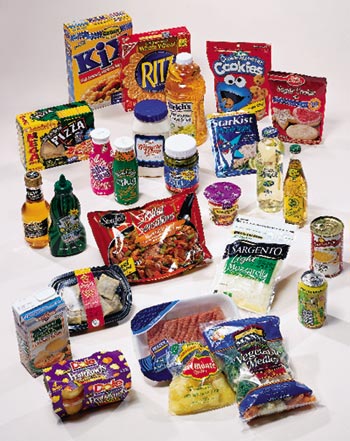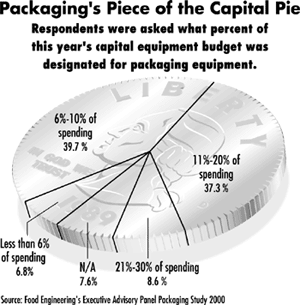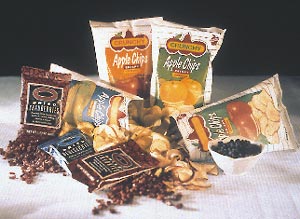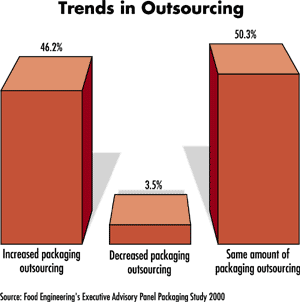
PRESSURE to perform
Crack the Whip is a good description of the work environment for food packaging specialists: As manufacturers strive to meet the demands of changing distribution channels, food safety concerns and new consumer expectations, there is a ripple effect on their plant personnel. At the end of the chain -- and the one getting the brunt of the backlash -- is the packaging engineer.Green ketchup in a bottle with an adjustable spout, plastic beer bottles and lunch offerings that combine multiple branded products in one package all are designed to create more sales, and they don't necessarily entail new production processes. But all are a potential headache for packaging, and that creates new pressures on packaging personnel.
That reality comes through loud and clear in Food Engineering's 15th Annual Packaging Trends Survey. Questionnaires were mailed this fall to 377 members of the magazine's executive advisory panel, resulting in reams of statistical data on equipment and material spending. More revealing than the raw numbers were the comments respondents offered. Whether it's bulk packs and displays demanded by mass merchandisers or the challenges of reclosable packages, engineers and managers are continually modifying packaging processes to meet new needs.
Fragmentation of distribution channels was the underlying reason for many respondents' comments on factors impacting packaging decisions. Whether it's bulk packaging for club stores or single-serve units for C-stores, plants must respond with more packaging sizes. "Mass merchandisers require different package configurations than traditionally required," one respondent noted. "Fewer customers who are more demanding and have more clout" are exerting new pressure on packaging, griped another.
Issues Impacting Packaging Decisions Ranked in order of importance
1. Growing importance of mass merchandisers in food sales 2. Growth of club stores 3. Changing requirements of quick-serve restaurants 4. Changing requirements of restaurateurs 5. Changing requirements of foodservice operatorsSource: Food Engineering's Executive Advisory Panel Packaging Study 2000
Almost four in 10 respondents indicated their firms have changed their packaging materials in the last year, and although cost is always a consideration (93 percent rate cost as a very important factor), improved functionality was the next most-frequently mentioned reason. "Better barrier properties, better shelf life" was a comment repeated by many respondents, as was resealability. "Moisture barrier improved," offered another.
Conversion from paperboard to plastic was the most frequently cited material change planned in the coming year (22.8 percent), with glass-to-plastic conversions close behind (15.6 percent).
Machinery changes were made by more than two-thirds of the respondents' firms (69.2 percent), with the need to achieve greater throughput the most common reason. Channel fragmentation also manifested itself in machinery purchase decisions, with the comment "flexibility and speed of changeover" a typical motivation. Almost half of respondents indicated they will spend between $100,000 and $200,000 on new packaging equipment this year, and more than a quarter anticipate spending $500,000 or more.
The need to either retrofit or completely replace lines to take advantage of state-of-the-art automation was the most frequently cited need. Elimination of ergonomic problems and greater flexibility also are pressing concerns. One respondent offered a laundry list of needs: "Automation, tighter controls, centralize monitoring, new plastic packaging, better labeling support, package durability." To which others might add, "Amen."

In-house or outsource
A surprisingly strong shift toward more outsourcing of work to contract packagers was indicated in the survey (see chart). One motivation is speed to market, with three in 10 respondents indicating contract- and co-packing is the favored strategy to accomplish that.The response is consistent with a survey by the Contract Packaging Association, which suggested double-digit growth is occurring in contract packing. But the limited size of CPA's survey sample casts some doubt on the findings, and the group is trying to develop more definitive information.
Even less conclusive are the findings of the purchasing plans study by the Packaging Machinery Manufacturers Institute. While 18.3 percent of surveyed manufacturers, including food and beverage firms, indicated they would give more work to contract packagers this year (8.2 percent plan a reduction), the base of companies outsourcing is virtually unchanged in the last three years.
PMMI's survey indicates food and beverage companies, while accounting for 54 percent of U.S. purchases of new packaging equipment, will play a diminished role in machine purchases this year. A year ago, food and beverage represented 58.7 percent of spending, according to PMMI.This segment expects to spend $2.89 billion this year for new packaging machinery, up 1.3 percent from 1999.
Top Food Packaging Issues Ranked in importance
1. Consumer convenience 2. Product safety 3. Faster packaging line speeds 4. Shelf life extension 5. Bulk sizes 6. Improvements in line automation 7. Improved graphics 8. Cost of primary materials 9. Environmental concerns 10. Labeling and coding improvementsSource: Food Engineering's Executive Advisory Panel Packaging Study 2000
A boom-bust cycle is at play rather than a trend toward diminished buying by food and beverage, suggests survey director Richard Kitrosser. Last year food and beverage firms increased their spending 17 percent, with much of the growth in purchases of vertical form/fill/seal (f/f/s) machines.
The beverage segment remains bullish, with this year's 10 percent spending hike matching 1999's rate in dollars spent. Food company spending is expected to contract, a change PMMI attributes to the leveling off of processed food production brought on by less in-home meal preparation. Corporate mergers also have led to plant closures and warehouses filled with unused packaging equipment.
Still, food and beverage companies are drivers in the packaging market, and the food industry's preferences are reflected in equipment purchasing trends. The Food Engineering survey respondent who disclosed his company "plans to go to form/fill/seal sometime soon" was mirroring what many other food processors are doing. That's reflected in last year's 24.6 percent spike in sales of f/f/s machines for bag and pouch filling, making it the hottest of 17 machinery categories tracked by PMMI.

Fill speeds topped out at 75 units a minute as recently as three years ago, according to Mitch Mekaelian, business development director at Lawson Mardon, a Northbrook, Ill.-based maker of f/f/s machines. Today's machines can output 200 to as many as 500 packages a minute. As a result, machine sales in food and beverage are increasing 25-30 percent, Mekaelian says. "There's a ground swell."
Machine application is getting an assist on the materials side, where new resins are facilitating faster machine speeds. An example is Affinity polyolefin plastomers, which recently won FDA approval for food contact. The Dow Plastics resin had already been approved as an adhesive.
Affinity can replace resins that require sealing temperatures of 194 degrees Fahrenheit, according to Jeff Wooster, value chain manager at Dow. These polyolefin plastomers seal at 150 degrees, which can result in 40 percent higher throughput on f/f/s equipment.

Good-for-you packaging
Another material advance is film with an anti-microbial agent to protect against pathogenic contamination. The first commercially available use of the concept could come as early as next year.Viskase Companies Inc. in Chicago has been developing casings for chub meats to control against Listeria for most of the last decade, and the packaging supplier expects to file the last of its toxicity studies with FDA by year-end. Patents were granted four years ago for a system incorporating a bacteriocin or synthetic antibacterial agent with a chelating agent to coat food-contact surfaces.
"We believe strongly that we can prove the efficacy of this product to the FDA, and once we prove it is effective and safe, I think it will become the norm for meats using casings," according to F. Edward Gustafson, president and CEO of Viskase. "Market interest is incredible."
The engineering issues in producing a cellulose tube with an anti-microbial element have been resolved, though the challenge of producing a film with such an agent remains. Viskase recently sold its plastic shrink film business for $245 million to Bemis Co. and is concentrating on the casings business, Gustafson says.
"If you use it as part of a total pathogen-prevention plan, it will work. But this is not a silver bullet," Gustafson emphasizes. "It can only be used as part of good manufacturing practices."
While Viskase is likely to be the first to market such packaging, many more will follow. Focus on food safety has produced a blizzard of federal grants to encourage research on similar packaging. Food scientists are developing films with natural anti-microbial agents such as chitosan, which is derived from crab shells and is already being marketed as a dietary supplement with fat-blocking properties.
Navam Hettiarachchy, a protein chemist in the food science department at the University of Arkansas, is among the corps of food scientists developing food films with anti-microbial protection. She recently was awarded a $403,000 grant from USDA to continue work on a soy protein film that incorporates plant extracts. Hettiarachchy already has achieved two-Log reductions in pathogens affecting freshly cut fruits and vegetables.
"As long as the consumer understands a film has no deleterious affect and that it is a natural substance, I think they will accept it," she says. "If people don't want to consume it, they can easily wash it off."
Protective films and coatings are becoming common in food packaging, though most consumers are unaware of them, believes Kay Cooksey, associate professor of food packaging at Clemson (S.C.) University and chair of the IFT's food packaging division. Raisins in cereal, for example, are regularly coated to prevent the surrounding bran flakes from getting soggy, and films are being sprayed on fruits and vegetables. What is new is packaging that proactively protects the product.
Outguessing finicky consumers
Protective films and casings are just part of the changes occurring in packaging materials. PET is on the brink of retortability: Schmalbach-Lubeca developed the container for Vlasic's pickles that can handle temperatures a full 20 degrees higher than the standard of a year ago. Fresh-cut fruits like Del Monte's pineapple chunks are appearing on grocers' shelves east of the Rockies thanks to films that can control their high respiration rates. And Star-Kist's minimally-processed tuna-in-a-pouch with an 18-month shelf life has made the transition from foodservice to retail."That packaging represents an immense change," suggests Ben Miyares, president of the Packaging Education Forum. "Of course, what makes a lot of sense isn't necessarily what consumers will buy."
"Finicky" consumers scuttle many packaging innovations, agrees Dow's Wooster, which is why most breakthroughs occur in foodservice first, if at all. "Those customers don't have an emotional component to their purchases," he points out. Star-Kist began converting fast food customers almost two years ago from #10 cans to pouches because of benefits such as less garbage, fewer workmen's comp claims, less draining and a better product.
Machinery changes are not as dramatic as those occurring in materials, but the movement toward more motion control in packaging has significant implications for food plant operators. Perhaps the greatest is the attendant need for personnel with mechanical and electronic skills.
"Mechatronic machines that have been redesigned from the ground up are bringing a host of significant benefits to users," according to Keith Campbell, director of automation and integration at Hershey Foods Corp. and chairman of Open Modular Architecture Control's (OMAC) Motion Control for Packaging Group. Faster throughput at the same or lower cost, smaller equipment footprints, faster changeovers and quicker delivery and setup of these servo-driven machines are among the benefits proponents tout.
Campbell's OMAC group includes representatives of both the food manufacturing and packaging supplier communities. The objective is to gain consensus on architectural connectivity and computer languages that make it possible to hook up automation equipment from multiple vendors and have them communicate with one another.
"You can't get the benefits just by taking induction motors off and putting on servos," he says. "If you do it the correct way, you find that it actually saves money."
Finding and retaining operators with the skills needed to maintain sophisticated systems will be a challenge. Kinematic, power transmission and software development expertise may be needed, and Campbell says part of his group's mission is "to work with schools to see if we can get them to develop new curriculums. Time isn't going to measured in months but in years and decades."
The conversion from mechanical to electronic packaging systems already is underway. How smoothly it progresses is as great an unknown as consumer acceptance of the plastic beer bottle.